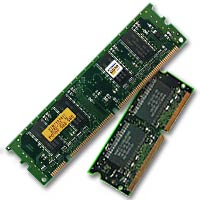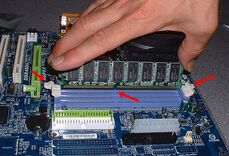by Megan Whitham
RAM (Random Access Memory) is an input/output device that contains data and processing instructions for a program, but only while the program is in use. It is necessary for RAM to have power constantly since it only stores short term memory. If one loses power while using RAM, the program will shut down and all the memory will be lost. It is therefore important that one has a reliable power supply. For more on the power supply, click here: http://wwstechnology.wikia.com/wiki/Power_Supply_2016-17_A
A picture of RAM
DRAM is made of transistors and capacitors that together form a memory cell that stands for one bit (either a 0 or 1) of data. The capacitor stores the data while the transistor controls whether the memory chip can read or change the capacitor's data. The capacitor loses its information quickly if the bit is a 1; therefore, the CPU or memory controller must help the capacitor maintain the 1.
The memory is made of bits in the form of a grid. Memory cells are carved into a thin plate of silicon in columns and rows. The columns are called bitlines and the rows are called wordlines. The address of a memory cell is determined by an intersection of bitlines and wordlines. A charge surges through a column to initiate the transistor for each bit in the column. The row decides whether the capacitor is a 1 or a 0 when writing occurs, and when the rows are being read, a sense-amplifier decides the amount of charge the capacitor has. If the charge is over 50%, it is read as a 1 while anything lower is a 0.
SRAM uses a type of Boolean logic, flip-flop[1], to hold the bits of memory. Each flip flop needs four to six transistors; however, it does not need to refresh like the DRAM does to maintain the 1. Therefore, SRAM is considerably faster than DRAM. Each SRAM cell takes up more space on a chip than a DRAM cell though, so it is more expensive since there is less memory per chip.
On a desktop, RAM used to be located on the motherboard and used a dual inline package (DIP), which used a system of pins. However, once people needed more memory, a new system was adopted. The memory chips and the supporting parts are now all placed on a printed circuit board (PCB). This board is then placed into a memory bank on the motherboard. For more on the motherboard, click here: http://wwstechnology.wikia.com/wiki/Motherboard_2016-17_AThere are many different types of RAM that fall under the two basic categories of DRAM and SRAM. There is FPM DRAM, EDO DRAM, SDRAM, DDR SDRAM and RDRAM, to name a few. For a more comprehensive list, look at this article[2] written by Jeff Tyson and Dave Coustan.
The very first inkling of RAM began with the Vacuum Tube, which controlled how electrons moved in a vacuumed space. The first computer to use a storage program like this was made in 1948. The computer was enormous, using 160 kilowatts of electrical power. Next, there was Drum Memory, which used a metal cylinder and punch cards. Drum Memory was replaced by Core Memory, which used a system of metal rings with wires running through them. For more on these interesting early forms of memory and a broader history of computer memory, click here[3].
Memory does not become like the RAM we know today until 1947, when the first transistors were created. This idea of using Boolean logic began with Latches (a circuit of transistors that stores one bit of data). This then developed into flip-flops, which were joined together to form a Register. It wasn't until 1968, though, that people realized a transistor and capacitor could work together and DRAM was invented. For a short video on the history of RAM, click here[4].


